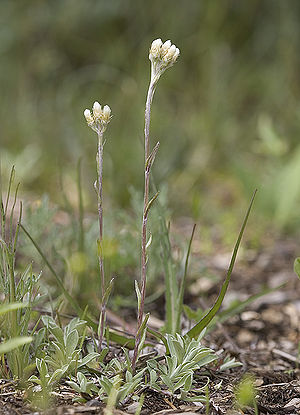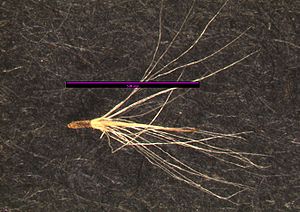Difference between revisions of "Antennaria howellii"
(Tag: VisualEditor) |
(→Plant Description) (Tag: VisualEditor) |
||
| (11 intermediate revisions by the same user not shown) | |||
| Line 1: | Line 1: | ||
| − | * | + | * Scientific Name: ''Antennaria'' ''howellii'' |
* Family: Asteraceae | * Family: Asteraceae | ||
* Common Names: Howell's pussytoes | * Common Names: Howell's pussytoes | ||
* Codon: ANTHOW | * Codon: ANTHOW | ||
| − | + | ---- | |
| + | [[File:ANHO_RodGilbert_veg_4-2005.jpg |thumb|Photo by Rod Gilbert. Also featured on Main Page]] | ||
| + | === Taxonomy === | ||
{{Taxobox | {{Taxobox | ||
| − | | image = | + | | image = |
| image_caption = Photo by Rod Gilbert. Also featured on Main Page | | image_caption = Photo by Rod Gilbert. Also featured on Main Page | ||
| − | | name = | + | | name = |
| regnum = [[Plant]]ae | | regnum = [[Plant]]ae | ||
| − | | subregnum = | + | | subregnum = Viridiplantae |
| − | | phylum = | + | | phylum = Tracheophyta |
| − | | subphylum= | + | | subphylum= Spermatophyta |
| classis = Magnoliopsida | | classis = Magnoliopsida | ||
| subclassis = Asteranae | | subclassis = Asteranae | ||
| ordo = Asterales | | ordo = Asterales | ||
| familia = Asteraceae | | familia = Asteraceae | ||
| − | | genus = | + | | genus = ''Antennaria'' Gaertn. |
| species = '''''Antennaria howellii''''' Greene | | species = '''''Antennaria howellii''''' Greene | ||
| subspecies = | | subspecies = | ||
}} | }} | ||
| − | + | <ref>Integrated Taxonomic Information System. Retrieved from https://www.itis.gov/servlet/SingleRpt/SingleRpt?search_topic=TSN&search_value=185118</ref> | |
| − | + | ||
| − | + | ||
===Plant Description=== | ===Plant Description=== | ||
| − | + | Perennial, dioceous herb with erect stems and spreading stolons, up to 4 dm tall.<ref name=":1" /> Basal leaves entire, oblanceolate,<ref name=":0">Illinois Wildflowers. Retrieved from | |
https://www.illinoiswildflowers.info/prairie/plantx/fld_pussytoesx.htm | https://www.illinoiswildflowers.info/prairie/plantx/fld_pussytoesx.htm | ||
| − | </ref> | + | </ref> green and glabrous above, white wooly below.<ref name=":1" /> Cauline leaves few, linear.<ref name=":1" /> Pseudanthia discoid with imbricate phyllaries.<ref name=":2">Hitchcock, C. L., Cronquist, A., Giblin, D., |
| − | + | & Legler, B. et al. (2018). ''Flora of the Pacific Northwest: an | |
| − | + | illustrated manual''. Seattle: University of Washington Press. p. 537.</ref> Male flowers with undivided style and sparse pappus; female flowers with bifid style and many capillary bristles.<ref name=":2" /> Achenes are terete.<ref name=":1" /> | |
===Bloom Period=== | ===Bloom Period=== | ||
May to July<ref name=":1">WTU Herbarium, Burke Museum, & University of | May to July<ref name=":1">WTU Herbarium, Burke Museum, & University of | ||
| − | Washington.https://biology.burke.washington.edu/herbarium/imagecollection/taxon.php?Taxon=Antennaria%20howellii</ref> | + | Washington. Retrieved from https://biology.burke.washington.edu/herbarium/imagecollection/taxon.php?Taxon=Antennaria%20howellii</ref> |
| − | + | ||
| − | + | ||
===Distribution=== | ===Distribution=== | ||
| − | + | Both sides of the Cascades crest;<ref name=":1" /> across Canada and the northern United States.<ref name=":2" /> | |
| − | + | ||
| − | + | ||
===Habitat=== | ===Habitat=== | ||
| − | + | Prairies to open woodlands, roadsides, disturbed sites.<ref name=":0" /> | |
| − | + | ||
| − | + | ||
| − | + | ||
====First Nations==== | ====First Nations==== | ||
| − | Use by the Bellacoola People (''Bí’lxula)'' as an analgesic<ref>Native American Ethnobotany Database. Retrieved from http://naeb.brit.org/uses/3606/</ref>, and by the Ojibwe (Anishinaabeg) as an infusion to purge | + | Use by the Bellacoola People (''Bí’lxula)'' as an analgesic<ref>Native American Ethnobotany Database. Retrieved from http://naeb.brit.org/uses/3606/</ref>, and by the Ojibwe (Anishinaabeg) as an infusion to purge afterbirth and to heal from child birth<ref>Native American Ethnobotany Database. Retrieved from http://naeb.brit.org/uses/3607/</ref>. |
====Other uses==== | ====Other uses==== | ||
Could be grown in rock gardens for spring bloom. | Could be grown in rock gardens for spring bloom. | ||
| − | |||
| − | |||
===Propagation=== | ===Propagation=== | ||
[[http://www.nativeplantnetwork.org/network/ViewProtocols.aspx?ProtocolID=14|Propagation Protocol from Native Plant Network]] | [[http://www.nativeplantnetwork.org/network/ViewProtocols.aspx?ProtocolID=14|Propagation Protocol from Native Plant Network]] | ||
| Line 83: | Line 74: | ||
{{Basics}} | {{Basics}} | ||
| − | ==Photo Gallery== | + | ===Photo Gallery=== |
<gallery> | <gallery> | ||
File:ANTHOW2.jpg|Photo: Bernard Kovalchik | File:ANTHOW2.jpg|Photo: Bernard Kovalchik | ||
| Line 89: | Line 80: | ||
</gallery> | </gallery> | ||
| − | ==References== | + | ===References=== |
| − | + | <references /> | |
| − | + | ||
| − | + | ||
| − | + | ||
| − | + | ||
| − | + | ||
| − | + | ||
| − | + | ||
Latest revision as of 14:23, 24 June 2021
- Scientific Name: Antennaria howellii
- Family: Asteraceae
- Common Names: Howell's pussytoes
- Codon: ANTHOW
Contents
Taxonomy
| Scientific classification | |
|---|---|
| Kingdom: | Plantae |
| Subkingdom: | Viridiplantae |
| Phylum: | Tracheophyta |
| Subphylum: | Spermatophyta |
| Class: | Magnoliopsida |
| Subclass: | Asteranae |
| Order: | Asterales |
| Family: | Asteraceae |
| Genus: | Antennaria Gaertn. |
| Species: | Antennaria howellii Greene |
Plant Description
Perennial, dioceous herb with erect stems and spreading stolons, up to 4 dm tall.[2] Basal leaves entire, oblanceolate,[3] green and glabrous above, white wooly below.[2] Cauline leaves few, linear.[2] Pseudanthia discoid with imbricate phyllaries.[4] Male flowers with undivided style and sparse pappus; female flowers with bifid style and many capillary bristles.[4] Achenes are terete.[2]
Bloom Period
May to July[2]
Distribution
Both sides of the Cascades crest;[2] across Canada and the northern United States.[4]
Habitat
Prairies to open woodlands, roadsides, disturbed sites.[3]
First Nations
Use by the Bellacoola People (Bí’lxula) as an analgesic[5], and by the Ojibwe (Anishinaabeg) as an infusion to purge afterbirth and to heal from child birth[6].
Other uses
Could be grown in rock gardens for spring bloom.
Propagation
[Protocol from Native Plant Network]
Seed
Seed sample from: 2009
Average Measurement: 1.1 x 0.3 x 0.2
Measurement Range: L: 0.9 - 1.5, W: 0.2 - 0.4, D: 0.1 - 0.3
Features
Shape: Slightly larger than Anaphalis margaritacea and has lighter, glossier, and more dimpled hilum.
Color: Brown.
Additional Structures: At opposite end of hilum is pappus of white hairs that attach in a ring around the end of the seed. Pappus is significantly longer that seed.
Surface: Seed is slightly grooved, hairy, and covered with white globules.
Could be confused with: Anaphalis margaritacea
Latitudinal Cross Section: elliptical ![]()
Longitudinal Cross Section: elliptical ![]()
Basic Explanations and Assumptions:
The dimensions for the seeds are length x width x depth. The location of the hilum is used as the base of the seed, and the length is measured from hilum to the opposite apex. Where a style is present, the length is measured from the hilum to the bottom of the style. Width is measured at a right angle to the length at the widest part. Depth is measured at a right angle to the intersection of height and width lines.
Measurements included are the mean average for each measurement of ten separate seeds.
All measurements in millimeters unless otherwise noted.
Photo Gallery
References
- ↑ Integrated Taxonomic Information System. Retrieved from https://www.itis.gov/servlet/SingleRpt/SingleRpt?search_topic=TSN&search_value=185118
- ↑ 2.0 2.1 2.2 2.3 2.4 2.5 WTU Herbarium, Burke Museum, & University of Washington. Retrieved from https://biology.burke.washington.edu/herbarium/imagecollection/taxon.php?Taxon=Antennaria%20howellii
- ↑ 3.0 3.1 Illinois Wildflowers. Retrieved from https://www.illinoiswildflowers.info/prairie/plantx/fld_pussytoesx.htm
- ↑ 4.0 4.1 4.2 Hitchcock, C. L., Cronquist, A., Giblin, D., & Legler, B. et al. (2018). Flora of the Pacific Northwest: an illustrated manual. Seattle: University of Washington Press. p. 537.
- ↑ Native American Ethnobotany Database. Retrieved from http://naeb.brit.org/uses/3606/
- ↑ Native American Ethnobotany Database. Retrieved from http://naeb.brit.org/uses/3607/




